After featuring Mario as a villain in Donkey Kong Jr., Nintendo’s next title in the Donkey Kong series… had nothing whatsoever to do with Kong. Instead, it focused solely on Mario, once again in the role of protagonist, in a game that in many ways seemed like a step backward in terms of design yet nevertheless paved the way for many masterpieces yet to come. I’m referring, of course, to Mario Bros.
How was it a step backward, you ask? Well, for one thing, it begins by completely sidestepping the Donkey Kong games’ “learn by doing” approach to design. Where both of its predecessors began with a simple plot setup leading directly into a gameplay scenario that taught players what they needed to do through clever visual cues and the thoughtful arrangement of on-screen objects, Mario Bros. gives you this when you first begin:
A quick, three-point tutorial on how to defeat the game’s enemies. Admittedly, the mechanics were fairly elaborate for an arcade game in 1983 (the same year that Dragon’s Lair dressed up mundane joystick presses with pretty artwork), but it seems sort of strange to see such no-frills instructions given before a vintage Nintendo game like this.
By returning to Mario as the protagonist, Mario Bros. brought back the more limited and intuitive mechanics of the original Donkey Kong. Mario here can run and jump, and that’s about it; he runs along horizontal surfaces, and horizontal movement is handled by jumping. He doesn’t even get to smack things with a hammer. One button is all you need.
However, Mario’s controls and physics aren’t simply carried over from the original Donkey Kong whole cloth. They’ve expanded and improved, with greater (albeit subtle) complexity for the player to contend with. Mario can now fall from any height — something you immediately take as given and for granted, as dropping from a high ledge is the only way to descend from the upper levels — and his jump has less forward momentum. Leaping in Donkey Kong was about vaulting hazards and traversing platforms, but that’s not the goal here. The platforming is utterly rudimentary, with the only danger inherent in jumping coming from the possibility of landing on an enemy, and you don’t earn points for soaring over a foe. The main purpose of a jump in Mario Bros. is to reach a higher platform and punch the ground from beneath an enemy’s feet, and for both purposes a more vertical arc is essential. The change takes some getting used to, but it’s a case of being given the proper tools for the job.
The other significant change for Mario comes in the addition of inertia. Movement in Donkey Kong was fairly binary: You were either moving or your weren’t, and once you stopped moving Mario would come to a stop almost immediately. He could turn on a dime. That’s not the case here; Mario spends the entire game dashing right and left, back and forth, but reversing direction isn’t as simple as making an instant change in direction. Instead, when you switch directions, Mario skids to a stop, his momentum taking him about a step forward before he’s able to turn about. Furthermore, when you begin running in either direction, Mario needs a couple of steps to warm up and get up to speed.
All of this would have been disastrous in Donkey Kong, a game of pixel-precise jumps and zero forgiveness for errors. In Mario Bros., however, it works just fine, as you never have to worry about sliding into a pit or not working up enough forward momentum to clear a pit. Given the simplified nature of its action, Mario Bros. could afford to experiment a bit with how Mario moved.
And the second major step backward appears as soon as you begin the first stage. This is a very different kind of game than Donkey Kong and Donkey Kong Jr. In many ways, it’s an older style of action. Mario’s first adventure offered quite the revolution in challenging players to best four different action scenarios, each completely different than the last. Donkey Kong was about earning a high score, yes, but you can legitimately consider the game “complete” upon conquering the fourth stage.
Mario Bros., on the other hand, never really changes. The screen layout remains consistent no matter how many stages you advance into the action. You’re always running through a four-tier wraparound sewer system flanked at the top and bottom by pipes that disgorge (or accept) monsters. The gaps always appear in the same places. And the slight elevation of the central platform remains consistent as well.
Someone at Nintendo seemed to be a pretty big fan of Midway’s Joust, because both this game and Balloon Fight demonstrate considerable design influence from John Newcomer’s masterpiece. Balloon Fight is the more obvious descendent, but Mario Bros. — with its tiered platforms and two-player simultaneous action — owes Joust a debt of gratitude as well.
Why the regressive approach from Donkey Kong? I can think of a few possible explanations.
For starters, the Donkey Kong games are defined by their restless design. Despite some consistency of concepts from game to game, no two Donkey Kong titles were ever alike until Donkey Kong Country 2 in 1995. As a spin-off, Mario Bros. gave Nintendo even more freedom to experiment with formats and mechanics.
Secondly, Donkey Kong‘s objective-based approach worked fine for a single-player game, but Mario Bros. is designed around multiplayer. As such, it needed to step back from the idea of running toward a goal and instead take a more sport-like approach as two players vied for top score. Of course the game is perfectly playable by one person alone, but it really shines in multiplayer. This was Nintendo’s first proper experiment in multiplayer outside of their dedicated Pong clone console Block Kuzushi, so it makes sense for them to have gone with a fairly conservative approach to get a proper handle on the ins and outs of the format.
And finally, we shouldn’t forget that Mario Bros. debuted in arcades the same day that the Famicom console first appeared in stores. Famicom, the console whose otherwise sterling Donkey Kong conversion omitted an entire level for space considerations. Already Nintendo had its eye on the home market; within two years, it would produce its final dedicated arcade machine (Arm Wrestling) to focus entirely on consoles. With the specs of Famicom clearly defined by the point, Nintendo would have been well aware of its limitations as they were designing Mario Bros. It’s a safe bet that the stage design, with a single layout rotating through different tile sets and color palettes, was created to ensure as faithful as possible a Famicom conversion.
The static layout doesn’t mean Mario Bros. lacked sophistication, though. Within its very carefully designed boundaries, this is the first game that really and truly feels like what we think of as a Mario game. Yes, the jump is more limited, and you can’t crush enemies by jumping on them. But there’s a remarkable amount of complexity and nuance in the mechanics and in the way players interact with the environment, with enemies, and with one another.
For starters, the basic control setup has a wonderfully cartoonish feel. No longer tasked with simply reaching the top of the screen, Mario now takes on enemies directly. Or rather, indirectly. Lacking a means to attack them head-on, he instead punches the ground from beneath them, stunning them momentarily and leaving them vulnerable to a well-placed kick. When Mario punches the ground (and it’s much clearer here than in any of the game’s sequels that he is indeed punching, not smashing things with his skull), the platform buckles comically, upending whatever happens to be directly above Mario’s fist. Turtles, crabs, insects, and more flip upside with a perturbed expression on their faces, fidgeting as they struggle to right themselves. Fail to kick them off the screen while they’re immobilized and they return to their usual patterns, but this time angrier and faster than before (just like Joust).
The game’s personality really shines through the enemies. The Shellcreepers — essentially prototype Koopa Troopas — comically hop out of their shells wearing nothing but underwear to kick them upright before resuming their march. Sidesteppers (crabs) take two punches to upend, with your first punch simply sending them into their angered movement patterns. To speed things along and keep players dropping their quarters into the coin catcher, a deadly fireball blasts through the stage after about a minute, much like Joust‘s pterodactyl (and, like the pterodactyl, it’s not indestructible — just very very difficult). Enemies move faster and come more frequently the longer you play, and eventually new hazards begin to appear.
Equally amusing is the opportunity for two-player interaction. Unlike previous multiplayer games, Mario Bros. isn’t strictly competitive. Yes, you’re gunning for a higher score than your partner, but it’s as much about cooperation and competition. Two players working together can blast through a single stage… but more likely they’ll either bumble into each other’s way or deliberately sabotage one another. Jump on the other player and his character will be squashed and stunned for a split second. Hit them from below and they won’t flip over, but they will fly upward — which can have deadly results if it happens at the wrong time. The spirit of help-or-hinder multiplayer is something Nintendo continues to explore with the Mario games, up to and including the upcoming Super Mario 3D World.
Once you reach the 10th stage or so, the most dangerous creature in the game begins to spawn: Small ice mounds called Slipice, which slink along to the center of a platform and take root, instantly freezing that entire platform and making Mario’s footing even more treacherous. I’m not sure where the idea of frozen ground creating unstable footing in a platformer came from, but this may actually be its genesis. Mario’s inertia is greatly enhanced by ice, causing him to take longer to stop while running and making him slower to start up again.
In a wonderfully thoughtful design twist, though, players are given the opportunity to get a handle on ice physics before they become a part of the standard scenario. Every few stages is a designated bonus stage in which players need simply dash as quickly as possible to collect coins scattered throughout the level minus any threats to contend with. The bonus stage immediately preceding Slipice’s debut takes place on entirely frozen ground, not only upping the difficulty of this bonus level over the one before it, but also giving you a chance to learn the dynamics of ice in a safe environment.
With the addition of ice in the form of both Slipice and falling icicles, Mario Bros. simply cranks up the speed, quantity, and frequency of its threats until it overwhelms the player. There is no end game here besides your reflexes failing you or the inevitable killscreen.
Still, despite appearing to be something of a regression into a simpler play style, Mario Bros. offers much to recommend it by. The specificity of its design allows for remarkable nuance and detail, and its multiplayer mechanics were hugely influential. Even accounting for what they borrowed from Joust, they went a step beyond what that game had accomplished and offered a fresh, entertaining experience. Mario Bros. really does seem like a logical midpoint between Donkey Kong and Super Mario Bros., and it allowed Nintendo’s designers to evolve Mario’s play style so they he’d be ready to revolutionize the medium a few years later.
P.S., Thanks as always to VG Museum for the images.
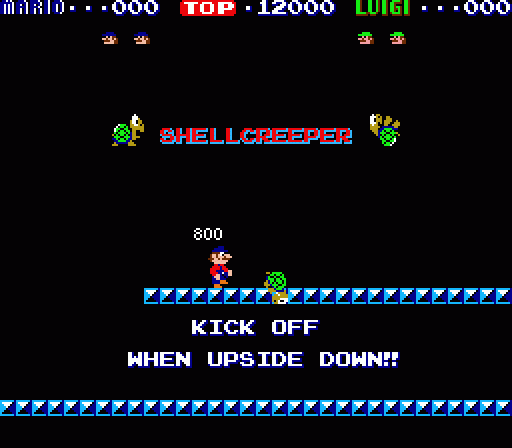

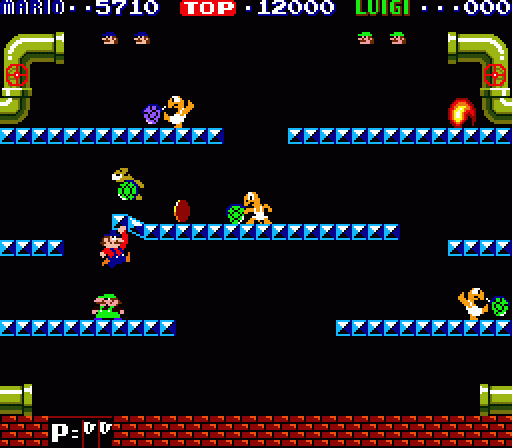
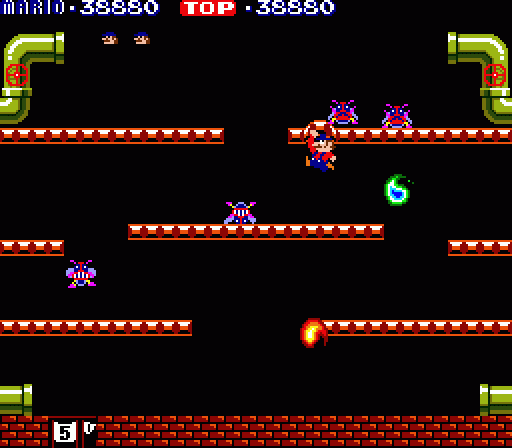
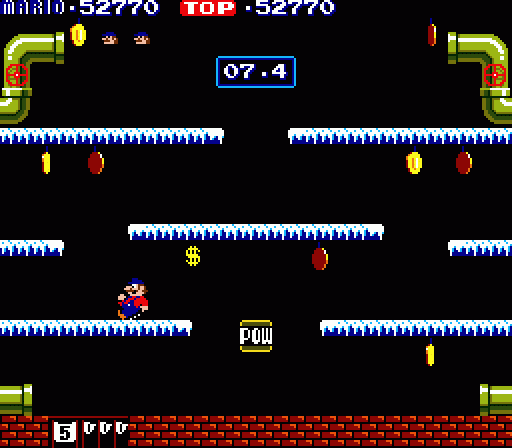
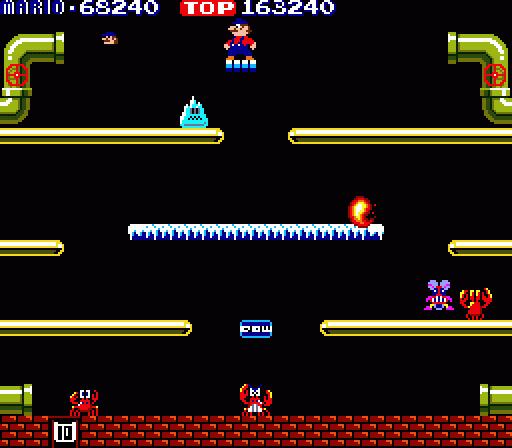
Fantastic write up! I never considered the parallels of Mario Bros. to Joust before. When does the kill screen happen…? At stage 256?
I always thought of Mario Bros. as Joust turned upsidedown.
I’d love to get a home port of the arcade game; I just love the better character art, animations, and so forth. Speaking of which, I enjoy that Super Mario World’s Koopa Troopas seemed to call back to the Shellcreepers here with the whole underwear/shell thing.
Incidentally, the GBA version included in that system’s Mario titles was good, too, and added new features and more, and changed the controls to be a bit more Mario-like, too, if I’m not mistaken.
Hey, did you ever see this?
http://www.youtube.com/watch?v=Wb55zig4EVg
Nintendo actually went back and improved Mario Bros. for the NES, making it a lot more like the arcade game. On the down side, it’s also a commercial for ramen or something. (The European version of the game strips all the noodle references out.)
Argh.
Hmm, not quite arcade-perfect, though; Mario and Luigi still look more like the NES versions.
It was, for Europe:
http://telebunny.net/talkingtime/showthread.php?t=11141
Figures.
It’s funny that you mention the game was designed to be converted faithfully to the NES/Famicom, because the Mario Bros. game on that system falls far short of arcade quality. The sprites are redrawn (badly) and the intermissions have vanished, but perhaps the worst crime of all is that the turtles no longer crawl out of their shells in their underwear once they’ve recovered from being flipped. Fortunately, Nintendo went back and did the game right a few years later, for the European and Japanese (but not the American… sigh) markets.
You make a really good point about Mario Bros. taking much of its inspiration from Joust, and that the game found a comfortable middle ground between Donkey Kong and Super Mario Bros. There are callbacks to Mario Bros. all over the place in SMB, from the pipes, turtles, and coins to the way you can knock out enemies by punching out the blocks underneath them.
So hey, since Donkey Kong 3 isn’t technically a Mario game, would you mind terribly if I covered it on my own blog? It’d give me a welcome break from bitching about the Xbox One.
I don’t mean to suggest Nintendo wanted a game they could make as a 1:1 port to NES, but both this and Donkey Kong 3 feel like games designed with the NES’s memory limitations in mind rather than to push the limitations of the arcade.
And you can write about anything you want, any time you want. You don’t need my permission.
“There are callbacks to Mario Bros. all over the place in SMB, from the pipes, turtles, and coins to the way you can knock out enemies by punching out the blocks underneath them.”
Almost like it’s a “Super” version of Mario Bros. =)
In addition to the POW blocks and fireballs as well. And don’t forgot it also was the introduction of Luigi.
Are the icicles in the arcade version? I thought they were only an addition for the enhanced GBA versions that came with the various Super Mario games…
I stand corrected! I guess I never got that far in the arcade to see them, but there they are…
It’s easy to take forgranted now, but even feeling like a step back from its predecessors, Mario Bros. set up a fair amount of the ground work for its super younger brother. In Mario Bros., we now have a Mario who doesn’t have glass legs, can bash things from underneath, can kick knocked over things, and skids instead of turning on a dime.
Speaking of Joust, the thing I’ve always found interesting about Balloon Fight (its more blatant imitator) is that it actually features a pretty wide range of level designs, along with an autoscrolling mode with randomly generated hazards. Not all the stages are winners, but Nintendo certainly had more ambition for Balloon Fight than just being a Joust clone.
Balloon Fight > Joust, in my humble opinion.
Nadia, on the other hand, feels differently.
I’m on Nadia’s side here. Joust has a superior artistic direction… screaming pterodactyls and fiery troll hands are more threatening to me than wandering sparks and hungry fish.
I won’t argue the coolness factor of ostriches and pterodactyls, but I think Balloon Fight just plays better. And the fish is awesome! As is the music.
Unless my memory is faulty, the Atari 5200 port I somehow managed to play before the arcade version didn’t include the tutorial explaining the whole flip then kick notion, and without it it took me quite a bit to realize just what I was supposed to be doing.
I think that might be right. Because I played it on the 7800 after being familiar with SMB, and seem to recall thinking the game was broken because I couldn’t kill enemies by jumping on top of them.
Since the coins appear after each enemy dies, I wonder if they’re somehow an inspiration for Pikmin’s ghosts.
I wonder how the Mario series would have evolved differently if Nintendo had continued making arcade games for the rest of the 80s and, in response, Mario games continued to develop the simpler design for multiplayer than the more complex design for single player that suited consoles. Imagine if in 1988 Nintendo had made a 4-player Mario arcade game with gameplay like New Super Mario Bros. Wii and tech comparable to Sega’s System 16 Super Scaler.
Not to pick nits, but as swell as Eugene Jarvis is, Joust was actually designed by John Newcomer.
Dammit, I always make that mistake. Thanks for the correction.